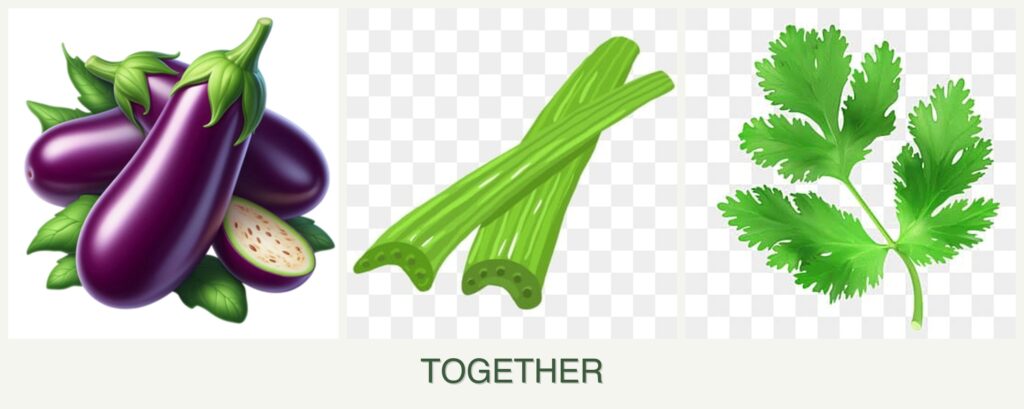
Can you plant eggplant, celery and parsley together?
Can You Plant Eggplant, Celery, and Parsley Together?
Companion planting is a gardening technique that involves growing certain plants together to enhance growth, deter pests, and maximize space. Many gardeners wonder if eggplant, celery, and parsley can be planted together. This article will explore their compatibility, benefits, and challenges, offering valuable insights and practical tips for successful planting.
Compatibility Analysis
Yes, you can plant eggplant, celery, and parsley together, but with some considerations. These plants can coexist harmoniously if their individual growth requirements are met. Eggplant thrives in warm, sunny conditions and requires well-drained soil. Celery prefers cooler temperatures and consistent moisture, while parsley is adaptable but benefits from partial shade in hot climates. The key to successful companion planting lies in understanding these needs and adjusting care accordingly.
Growth Requirements
- Eggplant: Requires full sun, warm temperatures, and well-drained soil. It needs regular watering but does not tolerate waterlogged conditions.
- Celery: Prefers cooler, moist environments with rich, organic soil. Consistent watering is crucial to prevent bitterness.
- Parsley: Grows well in partial shade and can adapt to various soil types. It needs moderate watering and thrives in well-drained soil.
Growing Requirements Comparison Table
| Plant | Sunlight Needs | Water Requirements | Soil pH | Hardiness Zones | Spacing | Growth Habit |
|---|---|---|---|---|---|---|
| Eggplant | Full Sun | Moderate | 5.5-7.0 | 4-10 | 18-24 in | Upright |
| Celery | Partial Shade | High | 6.0-7.0 | 2-10 | 6-8 in | Upright |
| Parsley | Partial Shade | Moderate | 5.5-6.7 | 4-9 | 6-12 in | Bushy |
Benefits of Planting Together
Companion planting eggplant, celery, and parsley can offer several benefits:
- Pest Repellent Properties: Parsley attracts beneficial insects like ladybugs and hoverflies, which can help control aphid populations on eggplants.
- Improved Growth: Celery can benefit from the shade provided by taller eggplant plants, reducing the risk of bolting in hot weather.
- Space Efficiency: Combining these plants maximizes garden space, especially in small gardens or containers.
- Soil Health: Different root depths and nutrient requirements can lead to a balanced soil ecosystem, reducing the need for fertilizers.
Potential Challenges
While these plants can coexist, there are potential challenges to consider:
- Competition for Resources: Eggplant and celery both require ample water, which can lead to competition if not managed properly.
- Different Watering Needs: Celery’s high water requirement may not align with eggplant’s preference for drier conditions between waterings.
- Disease Susceptibility: Eggplants are prone to fungal diseases, which can spread if celery’s moisture needs create overly damp conditions.
- Practical Solutions: Mulching can help retain moisture for celery while preventing waterlogging for eggplant. Regular monitoring and adjusting watering schedules can mitigate issues.
Planting Tips & Best Practices
- Optimal Spacing: Ensure adequate spacing—18-24 inches for eggplants, 6-8 inches for celery, and 6-12 inches for parsley.
- Timing: Plant celery early in the season, as it prefers cooler temperatures. Eggplant should be planted after the last frost when the soil is warm. Parsley can be planted in spring or fall.
- Container vs. Garden Bed: In containers, ensure proper drainage and choose a large enough pot to accommodate root growth. In garden beds, consider raised beds for better drainage.
- Soil Preparation: Amend soil with compost to enhance fertility and drainage. Test soil pH and adjust as needed with lime or sulfur.
- Companion Plants: Basil, marigolds, and nasturtiums can also be planted alongside these vegetables for additional pest control and aesthetic appeal.
FAQ Section
-
Can you plant eggplant and celery in the same pot?
- It’s possible, but ensure the pot is large enough and provides adequate drainage and space.
-
How far apart should these plants be planted?
- Eggplant: 18-24 inches, Celery: 6-8 inches, Parsley: 6-12 inches.
-
Do eggplant and celery need the same amount of water?
- No, celery requires more consistent moisture, while eggplant prefers to dry out slightly between waterings.
-
What should not be planted with eggplant, celery, and parsley?
- Avoid planting eggplant with fennel and celery with corn. Parsley should be kept away from lettuce.
-
Will eggplant affect the taste of parsley?
- No, planting eggplant near parsley does not affect its taste.
-
When is the best time to plant these plants together?
- Plant celery in early spring, eggplant after the last frost, and parsley in spring or fall for best results.
By understanding the needs and benefits of eggplant, celery, and parsley, gardeners can successfully integrate these plants into a thriving vegetable or herb garden. With careful planning and attention to detail, companion planting can enhance growth, deter pests, and make the most of available space.



Leave a Reply